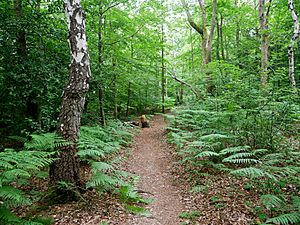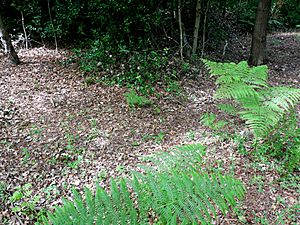Hayes Common facts for kids
| Site of Special Scientific Interest | |

Pathway through the Hayes Common Site of Special Scientific Interest
|
|
| Area of Search | Greater London |
|---|---|
| Interest | Biological |
| Area | 2.5 hectares |
| Notification | 1987 |
| Location map | Magic Map |
Hayes Common is a large, open area of land in Hayes, London. It covers about 79 hectares (195 acres). This special place is owned and looked after by Bromley Council. It's important for nature and is a Site of Metropolitan Importance for Nature Conservation. A small part of it is also a Site of Special Scientific Interest.
Hayes Common has lots of trees and open heathland. You can explore it using its many bridleways and footpaths. It's one of the biggest common lands in Greater London, with over 91 hectares (225 acres) of protected common land.
Contents
The Story of Hayes Common
Archaeologists have found old tools and signs of human life at Hayes Common. They found pieces from the late-Neolithic period, which was a very long time ago. They also found ditches, pits, and holes from the Bronze Age. This shows people lived and used this land thousands of years ago.
What's in a Name?
The name Hayes was first recorded in 1177 as hoese. This old Anglo-Saxon word means "a settlement in open land overgrown with shrubs and rough bushes." This tells us what the area might have looked like a long time ago.
How People Used the Common
For hundreds of years, local people used Hayes Common for many things. They would collect firewood from the trees. They also let their cattle and other animals graze here. By the early 1800s, it was home to the Hays Fair. This fair was a popular day out for people living in London. The common has also been the place where the London May Queen is crowned. This tradition has been happening for over 100 years!
Protecting the Land
In the 1860s, the owner of the land, Sir John Lennard, started selling parts of nearby West Wickham Common for houses. People who used Hayes Common worried their land would be sold too. They worked together to stop this from happening. In 1869, Hayes Common became the first common to be protected by a law called the Metropolitan Commons Act 1866. This law stopped the land from being fenced off and built on.
In 1937, the Municipal Borough of Bromley officially took ownership of the common. Later, in 1965, the London Borough of Bromley became the owner. To help look after the common, a group called the Friends of Hayes Common was started in 2000.
Hayes Common During World War II
During the Second World War, Hayes Common played a role in defending London. There were eight anti-aircraft guns placed there. Four of these were large 4.5-inch guns on permanent bases. The other four were mobile 3.7-inch guns. These guns were used to shoot down enemy planes.
Site of Special Scientific Interest
A small part of Hayes Common, about two hectares, is part of the Keston and Hayes Commons Site of Special Scientific Interest (SSSI). An SSSI is a special area protected by law because of its important wildlife, plants, or geology. In 2008, this part of the common was described as "unfavourable recovering." This means it was getting better after some problems.
Getting to Hayes Common
You can get to Hayes Common from many different roads. These include Baston Road, Baston Manor Road, Five Elms Road, Croydon Road, Prestons Road, Warren Road, West Common Road, and Commonside.
The Hayes railway station is nearby, and there are also local buses that can take you close to the common.



